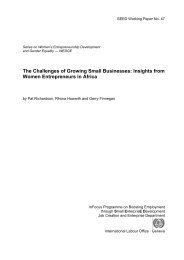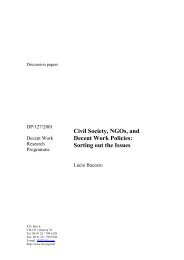Social and Solidarity Economy: Our common road towards Decent ...
Social and Solidarity Economy: Our common road towards Decent ...
Social and Solidarity Economy: Our common road towards Decent ...
You also want an ePaper? Increase the reach of your titles
YUMPU automatically turns print PDFs into web optimized ePapers that Google loves.
SOCIAL AND SOLIDARITY ECONOMY ACADEMY<br />
Figure 1.1: Combined social <strong>and</strong> economic objectives<br />
Participation<br />
Economic <strong>and</strong><br />
<strong>Social</strong> Function<br />
Voluntary<br />
Involvement<br />
<strong>Social</strong> <strong>and</strong><br />
<strong>Solidarity</strong><br />
<strong>Economy</strong><br />
Collective<br />
dimension<br />
Autonomy<br />
<strong>Solidarity</strong><br />
Since the economies of most countries operate<br />
according to market principles, goods <strong>and</strong> services<br />
supplied by SSEOs are traded in those markets <strong>and</strong><br />
compete with the goods, products <strong>and</strong> knowledge<br />
supplied by other private operators. However, in<br />
certain cases, (particularly with social services),<br />
public service rules serve as a reference. The social<br />
economy may also have to create special markets –<br />
such as the fair trade market – where market<br />
economy principles (particularly competition) are<br />
combined with certain features (e.g positive<br />
externalities for a group of producers or<br />
environmental protection).<br />
The fact that the SSE combines social <strong>and</strong> economic<br />
objectives is considered paradoxical by some<br />
economic actors. Some public authorities also find it<br />
difficult to position SSEOs in public policies that are<br />
often elaborated in silos more than in<br />
comprehensive approaches. Including the social,<br />
financial <strong>and</strong> environmental dimensions of<br />
sustainability is indeed a challenge for SSEOs.<br />
1.3.2 Whose economy?<br />
The social economy is sometimes confused with an<br />
economy of the poor or “for the poor <strong>and</strong> other<br />
vulnerable categories,” such as women, disabled<br />
persons, low-skilled workers, migrants or young<br />
workers. This is certainly not a criterion for<br />
distinguishing the social economy from other forms<br />
of economy. The social economy is not, by<br />
definition, an economy of the poorest or most<br />
vulnerable. It is, in fact, a choice that is made.<br />
People can choose to combine (economic, social,<br />
environmental or other) objectives, not maximize<br />
the financial return on investment <strong>and</strong> establish<br />
participatory governance.<br />
However, this perception of the social economy is<br />
not altogether incorrect. By virtue of the solidarity<br />
principles <strong>and</strong> mechanisms involved, enterprises<br />
<strong>and</strong> organizations of social economy are often the<br />
only forms accessible to people who cannot<br />
mobilize sufficient capital or other resources to<br />
launch <strong>and</strong> develop economic activities. And, as<br />
Jacques Defourny (1992) has stated so aptly,<br />
6<br />
READER

















